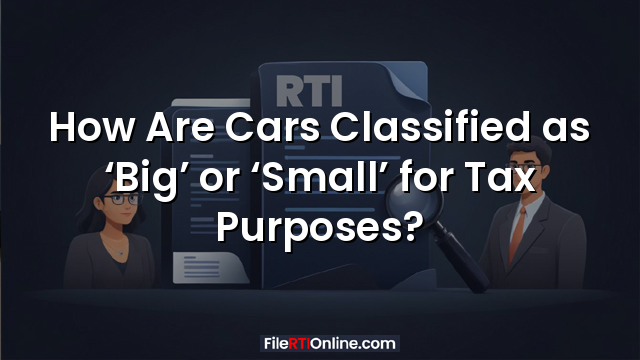How Are Cars Classified as ‘Big’ or ‘Small’ for Tax Purposes? Understanding the Definition Through an RTI Case
The classification of cars as “big” or “small” plays a major role in determining the excise duty imposed Government of India. For years, car manufacturers and consumers have debated how vehicles should be categorized for taxation:
Should the criteria be the length of the car or the ex-factory price?
A recent case before the Central Information Commission (CIC) sheds light on this issue. The matter arose when a citizen used the Right to Information (RTI) Act to question the Ministry of Finance about how excise duty on diesel cars is determined, why certain cars are classified as small despite being expensive, and whether manufacturers are manipulating vehicle length to reduce tax liability.
This article explains the classification criteria, the RTI case, and the broader implications for taxation and transparency.
Current Legal Position: How Are Cars Defined as ‘Big’ or ‘Small’?
In India, the excise duty on vehicles has historically been based on:
- Length of the vehicle, and
- Type of engine/fuel (petrol or diesel)
For instance:
- Cars under 4 meters with small engine capacities attract a lower excise duty
- Cars above 4 meters or with larger engines fall under the higher tax slab
This has led manufacturers to:
- Reduce length of certain models
- Re-engineer existing cars to fit under 4 meters
- Launch premium, high-priced compact cars to benefit from lower taxes
Examples include:
- Maruti Swift Dzire (shortened to fall under the 4-meter rule)
- Many luxury hatchbacks priced high but benefiting from small-size classification
Whether this is a loophole or a legitimate business strategy is a matter of constant public debate.
Background of the RTI Case: Citizen Seeks Clarity on Car Classification
A citizen filed an RTI application with the Ministry of Finance, Department of Revenue. The queries included:
- Whether the Union Petroleum Minister had written to the Finance Minister recommending increased duty on diesel cars
- Whether small and big cars are defined by length rather than ex-factory price
- Whether car manufacturers are taking advantage of the length-based definition
- What steps the government is taking to prevent revenue loss
- Complete records, file notings, and correspondence relating to these issues
The applicant also requested details about action taken on his grievance titled “Excise Duty on Diesel Cars” submitted through the PG Portal.
The Public Information Officer (PIO) gave partial replies but refused to answer key questions, claiming:
- Some information was “not maintained”, and
- Some queries did not fall under Section 2(f) of the RTI Act, which defines “information”.
Proceedings Before the Central Information Commission
During the CIC hearing:
Department’s Stand
The PIO argued that:
- The Department of Revenue does not maintain the specific documents relating to action taken on the appellant’s grievance
- The rest of the questions were not “information” but opinions, clarifications, or explanations, which they are not legally required to provide under RTI
According to the PIO, questions asking “is it true” or “why does the government do X” are not covered under Section 2(f), since the Act only mandates disclosure of existing records.
Commission’s Findings
The CIC disagreed with the evasive and incomplete approach of the department.
The Commission held that:
- The applicant had sought specific and identifiable information, not opinions
- The PIO must provide clear and categorical answers wherever records exist
- The government cannot deny action-taken details merely that information is “not maintained”
- Any action taken on complaints routed through the PG Portal must be disclosed
CIC Directions
The Central Information Commission issued two key directions:
- The PIO, Department of Revenue, must provide clear and categorical information on the questions asked appellant.
- The PIO must furnish the action taken report on the appellant’s submission titled “Excise Duty on Diesel Cars” that was forwarded through the PG Portal.
These directions ensure transparency and prevent ministries from avoiding accountability vague responses.
Why This Case Matters: Key Takeaways for Citizens
This RTI case provides several important insights:
1. Car classification criteria affects taxes, prices, and consumer decisions
Many citizens are unaware that a high-priced car can still be classified as “small” purely because it measures under 4 metres.
2. Manufacturers may redesign cars to fit into lower tax brackets
This case confirms the public suspicion that vehicle length plays a major role, sometimes more than price or luxury features.
3. Government departments must maintain action records
The CIC made it clear that ministries cannot claim that action taken on grievances is “not maintained”.
4. You can seek detailed tax policy information under RTI
Citizens can question policy implementation, loopholes, and revenue concerns.
5. Vague responses can be challenged before the CIC
If an RTI reply is incomplete or evasive, you can appeal to the Commission for a binding direction.
Conclusion
The RTI Act remains one of the most powerful tools for ensuring government transparency in India. This case illustrates how citizens can use RTI to question tax classifications, hold ministries accountable, and obtain clear records of government action.
The question of whether cars should be classified by length or ex-factory price continues to be debated, but through RTI, citizens can demand clarity, prevent misuse of tax structures, and ensure that public revenue is protected.

